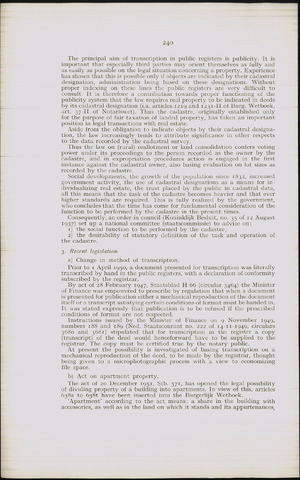240
The principal aim of transcription in public registers is publicity. It is
important that especially third parties may orient themselves as fully and
as easily as possible on the legal situation concerning a property. Experience
has shown that this is possible only if objects are indicated by their cadastral
designation, administration being based on these designations. Without
proper indexing on these lines the public registers are very difficult to
consult. It is therefore a contribution towards proper functioning of the
publicity system that the law requires real property to be indicated in deeds
by its cadastral designation (i.a. articles 1219 and 1231-II of Burg. Wetboek,
art. 37-II of Notariswet). Thus the cadastre, originally established only
for the purpose of fair taxation of landed property, has taken an important
position in legal transactions with real estate.
Aside from the obligation to indicate objects by their cadastral designa
tion, the law increasingly tends to attribute significance in other respects
to the data recorded by the cadastral survey.
Thus the law on (rural) reallotment or land consolidation confers voting
power under its proceedings to the person recorded as the owner by the
cadastre, and in expropriation procedures action is engaged in the first
instance against the cadastral owner, also basing evaluation on lot sizes as
recorded by the cadastre.
Social developments, the growth of the population since 1832, increased
government activity, the use of cadastral designations as a means for in
dividualizing real estate, the trust placed by the public in cadastral data,
all this means that the task of the cadastre becomes heavier and that ever
higher standards are required. This is fully realized by the government,
who concludes that the time has come for fundamental consideration of the
function to be performed by the cadastre in the present times.
Consequently, an order in council (Koninklijk Besluit, no. 35 of 12 August
1957) set up a national committee (staatscommissie) to advise on
ij the social function to be performed by the cadastre;
2) the desirability of statutory definition of the task and operation of
the cadastre.
3. Recent legislation
a) Change in method of transcription.
Prior to 1 April 1950, a document presented for transcription was literally
transcribed by hand in the public registers, with a declaration of conformity
subscribed by the registrar.
By act of 28 February 1947, Staatsblad H 66 (circular 3464) the Minister
of Finance was empowered to prescribe by regulation that when a document
is presented for publication either a mechanical reproduction of the document
itself or a transcript satisfying certain conditions of format must be handed in.
It was stated expressly that publication is to be refused if the prescribed
conditions of format are not respected.
Instructions issued by the Minister of Finance on 9 November 1949,
numbers 188 and 189 (Ned. Staatscourant no. 222 of 14-11-1949, circulars
3680 and 3681) stipulated that for transcription in the register a copy
(transcript) of the deed would henceforward have to be supplied to the
registrar. The copy must be certified true by the notary public.
At present the possibility is investigated of basing transcription on a
mechanical reproduction of the deed, to be made by the registrar, thought
being given to a microphotographic process with a view to economizing
file space.
b) Act on apartment property.
The act of 20 December 1951, Stb. 571, has opened the legal possibility
of dividing property of a building into apartments. In view of this, articles
638a to 638t have been inserted into the Burgerlijk Wetboek.
'Apartment' according to the act means: a share in the building with
accessories, as well as in the land on which it stands and its appurtenances,

